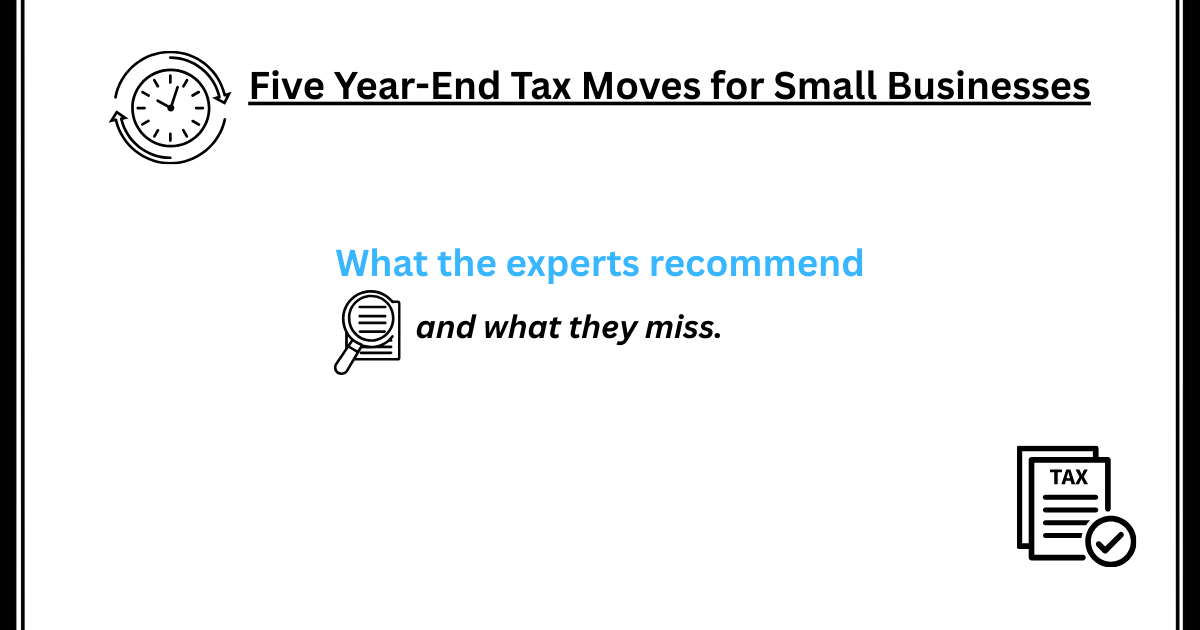Manual tracking is a liability for medium to large enterprises managing hundreds or thousands of fixed assets. Imagine your team buried in depreciation spreadsheets, cross-referencing purchases, checking formulas. One error, and your financials are off by thousands.
On the flip side, companies with mature fixed asset management processes experience 35% fewer audit adjustments and complete audits 12 days faster than peers still using manual methods.
Fixed asset accounting software automates complex calculations, ensures compliance, and provides audit trails that spreadsheets cannot deliver. But with dozens of solutions available, how do you choose?
Here’s how.
This guide compares the top 7 fixed asset accounting software solutions for 2025, examining each tool on the following parameters:
- Use case/Best for
- Key strengths
- Pricing
- Depreciation Methods
- Asset Capacity
- Ideal Company Size

Why Medium to Large Enterprises Need Dedicated Fixed Asset Accounting Software
Spreadsheets served finance teams well enough when asset counts were manageable. But as enterprises scale—adding locations, acquiring companies, expanding equipment fleets—the manual approach breaks down fast.
The pain points facing enterprise finance teams.
Managing thousands of assets across multiple locations creates coordination nightmares. When your manufacturing facility in Ohio purchases equipment while your distribution center in Texas disposes of vehicles, keeping a central spreadsheet accurate becomes nearly impossible. Version control issues multiply, and the risk of working from outdated data increases with every transaction.
Complex depreciation requirements demand simultaneous tracking across multiple methods. Your financial statements require GAAP straight-line depreciation while tax reporting uses MACRS. Running these calculations manually for hundreds of assets means hours of repetitive work and exponentially more opportunities for error.
Audit compliance and regulatory scrutiny have intensified. As Deloitte's 4Q 2024 CFO Signals survey reveals, 42% of CFOs prioritize enterprise risk management in 2025, with compliance frameworks receiving heightened attention from audit committees.
Fixed asset misstatements remain among the most common audit findings, and the documentation requirements continue to expand.
According to research on manufacturing controllers' challenges, companies with effective fixed asset management systems report 23% fewer compliance issues and 18% better financial accuracy—but achieving this requires moving beyond spreadsheets.
How Fixed Asset Management Software Benefits You
What if you could cut your month-end fixed asset reporting from days to minutes while eliminating calculation errors? Modern fixed asset software delivers exactly that, plus four additional advantages that strengthen your entire financial operation.
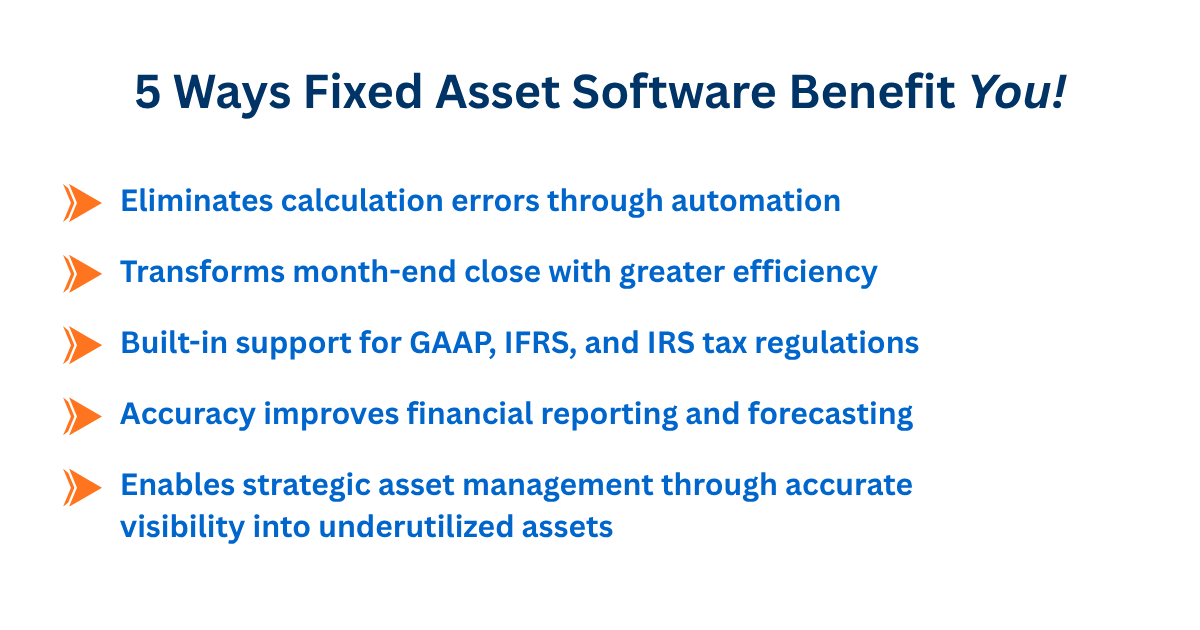
Automation eliminates calculation errors. Dedicated software calculates depreciation across thousands of assets in minutes, applying the correct methods, conventions, and recovery periods automatically. What once took days now happens with a single click, and the calculations are consistent every time.
Accuracy improves financial reporting and forecasting. When asset values, accumulated depreciation, and disposal gains accurately reflect reality, your balance sheet and income statement become reliable tools for decision-making rather than approximations requiring constant adjustment.
Compliance becomes manageable rather than overwhelming. Built-in support for GAAP, IFRS, and IRS tax regulations, combined with automatic updates when depreciation rules change, means your team stays compliant without becoming tax law experts.
Efficiency transforms month-end close. According to CPCON Group's analysis, organizations implementing robust fixed asset software reduce financial close time for fixed asset reporting by up to 40%. That time savings translates directly to faster closes and more capacity for strategic analysis.
Visibility enables strategic asset management. Complete audit trails, detailed transaction histories, and comprehensive reporting transform fixed assets from a compliance obligation into a strategic resource. You can identify underutilized assets, optimize replacement timing, and plan capital expenditures based on data rather than guesswork.
Did You Know? According to industry research, companies with mature fixed asset management processes experience 35% fewer audit adjustments and complete audits 12 days faster than organizations still relying on manual tracking methods.
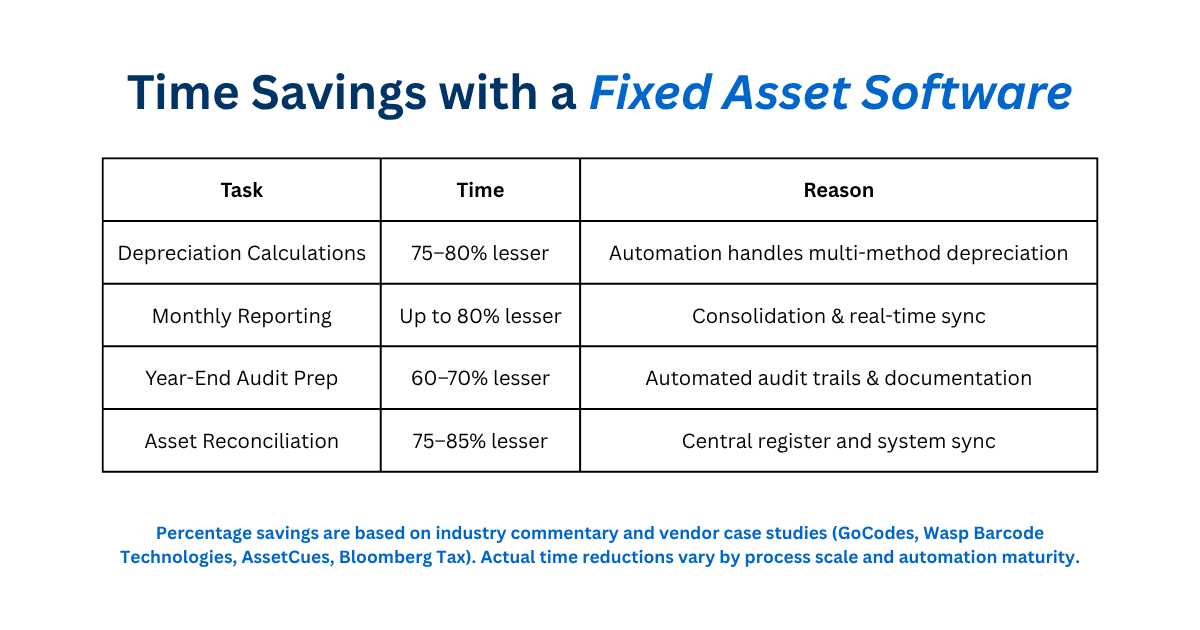
Essential Features to Look for in Fixed Asset Accounting Software
When evaluating fixed asset accounting software for your enterprise, focus on capabilities that directly impact your accounting workflows, compliance requirements, and operational efficiency. The best solutions share these core features—and missing even one can significantly limit your system's effectiveness.
1. Multiple Depreciation Methods
Enterprise-grade software must support 20+ depreciation methods including straight-line, MACRS (Modified Accelerated Cost Recovery System), ACRS (Accelerated Cost Recovery System), declining balance variations, sum-of-years-digits, and custom methods tailored to specific asset types or industry requirements.
The ability to run multiple depreciation books simultaneously is non-negotiable. Your financial statements require book depreciation (typically straight-line under GAAP) while tax returns demand tax depreciation (often MACRS). Managing these dual calculations manually creates endless opportunities for error and reconciliation headaches.
Advanced systems give controllers complete visibility into how depreciation decisions impact financial statements across multiple periods by:
- Calculating prior accumulated depreciation
- Computing current period depreciation
- Projecting remaining asset life
- Running what-if scenarios for asset additions or disposals
Why it matters: Accurate depreciation directly affects your balance sheet (asset values, accumulated depreciation), income statement (depreciation expense), and tax liability. Miscalculations ripple through every financial statement and can trigger costly audit adjustments or IRS penalties.
2. Comprehensive Reporting Capabilities
Look for solutions offering 20+ pre-built standard reports covering common accounting needs: depreciation schedules, asset registers, disposal reports, transfer logs, projection reports, and tax compliance documentation. These standard reports should be immediately usable without customization, saving implementation time and ensuring you can generate required reports from day one.
Equally important is a custom report builder, ideally with SQL support for complex queries. As your reporting requirements evolve, you need the flexibility to create specialized reports without waiting for vendor customizations or paying consulting fees for basic modifications.
Export capabilities matter more than many realize. Your reports must export cleanly to Excel, PDF, and CSV formats for distribution to stakeholders, auditors, and regulatory bodies. Poor export formatting creates unnecessary cleanup work and delays information delivery.
Why it matters: CFOs and controllers spend significant time preparing reports for management, audit committees, external auditors, and tax authorities. Comprehensive reporting capabilities transform what could be days of manual compilation into minutes of automated generation.
3. Asset Lifecycle Management
Track the complete journey of each asset from acquisition through disposal. This includes recording original purchases, subsequent improvements or enhancements, transfers between locations or cost centers, partial disposals, and final retirement or sale.
Maintaining a detailed transaction history and complete audit trail for every asset becomes critical during audits and provides the documentation needed to support financial statement assertions. When auditors ask about a specific asset's acquisition date, improvements made, or disposal calculations, you need immediate access to complete records.
Effective categorization and grouping capabilities allow logical organization by asset type, location, department, cost center, or any other relevant dimension, making reporting and analysis far more meaningful.
Why it matters: Complete lifecycle visibility ensures nothing falls through the cracks. Assets aren't mysteriously "lost" from your books, disposals are properly documented, and transfers maintain accountability across organizational boundaries.
4. Data Import & Migration Tools
Seamless import from Excel spreadsheets and legacy fixed asset tracking software removes the largest barrier to implementation. The transition from manual tracking to automated software should take days, not months—and that requires robust import capabilities.
Bulk upload functionality for thousands of assets, combined with data validation and error checking during import, prevents the "garbage in, garbage out" problem that plagues system implementations. The software should flag potential issues (missing required fields, illogical dates, invalid asset classifications) before they corrupt your new system.
Support for historical data migration ensures you don't lose years of depreciation history during the transition. Your new system should accept prior period transactions, accumulated depreciation balances, and historical acquisition data—maintaining continuity with past financial statements.
Why it matters: A smooth migration means faster time-to-value and higher user adoption. When implementation is painful and data migration problematic, projects stall and teams resist the change.
5. Multi-User Environment
Enterprise fixed asset management requires collaboration. Your solution must support multiple concurrent users (typically 2-4+ licenses depending on package tier) with the ability to access and update records simultaneously without conflicts or lock-outs.
Role-based access controls and granular permissions ensure proper segregation of duties. Asset managers can enter new purchases, accountants can run depreciation calculations, and controllers can review reports—all with appropriate access levels that maintain security and compliance.
User activity tracking and audit logs document who made what changes when, providing the accountability and transparency that auditors demand and internal controls require.
Why it matters: Finance operations don't function in isolation. Multiple team members need access to asset data, and forcing users to take turns or work around a single-user system creates bottlenecks and reduces productivity.
6. Multi-Entity/Location Support
For organizations with multiple business units, subsidiaries, or physical locations, the ability to track assets across entities while maintaining consolidated and separate reporting is essential. You need visibility into the entire organization's asset base while still producing entity-specific reports for management and compliance purposes.
Department and cost center allocation capabilities ensure depreciation expense flows to the correct areas of your income statement, supporting accurate profitability analysis by business segment.
Why it matters: Multi-location operations are the norm for medium to large enterprises. Without proper multi-entity support, you're forced into maintaining separate systems or creating complex manual consolidations.
7. Ease of Use & Navigation
An intuitive interface that doesn't require extensive financial or technical background to operate delivers faster adoption and reduces training requirements. When asset managers, accountants, and financial analysts can navigate the system confidently within days rather than months, ROI accelerates.
Straightforward asset entry and management workflows, easy-to-navigate menus, and logical screen organization minimize the learning curve. The system should guide users through complex transactions (like partial disposals or asset splits) without requiring them to reference manuals constantly.
Why it matters: The most feature-rich platform delivers zero value if users can't or won't use it effectively. As one Federal Tax Manager noted about Bassets, "The best part of this tool is very easy to use and easy to navigate as it does not require much of a financial background."
8. Customer Support & Training
Access to technical experts during implementation and beyond makes the difference between successful adoption and abandoned software. Look for vendors providing dedicated account managers, comprehensive onboarding, and responsive ongoing support.
Complex depreciation scenarios arise regularly—mid-year conventions, bonus depreciation elections, Section 179 expensing decisions, disposition calculations. When questions emerge, you need access to depreciation experts who can guide you through the accounting treatment, not just explain where to click.
Regular software updates and automatic compliance refreshes ensure your system stays current with changing tax laws and accounting standards without requiring manual intervention.
Why it matters: Software is only as valuable as your team's ability to use it correctly. As a Finance Controller shared, "As someone with little depreciation experience before using Bassets, their team quickly connected me with a technical expert who patiently guided me through the process."
Expert Tip: Prioritize software vendors that offer robust support and training resources. Even the most feature-rich platform fails without proper implementation assistance. Look for vendors providing access to technical experts who can guide you through complex depreciation scenarios—not just technical support staff reading from scripts.
Additional Considerations
Scalability ensures the platform handles your current asset volume plus anticipated growth. If you're managing 5,000 assets today but expect 15,000 within three years, verify the software scales appropriately without forcing a platform migration.
Compliance automation through automatic tax law updates relieves your team from constantly monitoring IRS publications for depreciation rule changes. The software should update depreciation tables, bonus depreciation percentages, and Section 179 limits automatically.
Top 7 Fixed Asset Accounting Software Solutions for 2025
Based on our analysis of the leading fixed asset tracking software, here are the top 7 solutions for medium to large enterprises in 2025. Each offers distinct advantages depending on your organization's specific needs, existing technology infrastructure, and operational preferences.
1. Sage Fixed Assets
Pros:
- Comprehensive depreciation engine with the broadest method support in the market
- Seamless integration with major ERP systems (Microsoft Dynamics, Oracle, SAP)
- Modular design allows purchasing only needed functionality (depreciation, tracking, planning, reporting)
- Strong compliance features with automatic tax law updates
- Partnership with WebHouse enables secure cloud hosting for remote teams
Cons:
- Higher price point than some alternatives
- Complexity can overwhelm organizations with straightforward depreciation needs
- Implementation requires significant setup time for optimal configuration
Notable Features: Sage Fixed Assets excels in environments where integration with existing ERP systems is critical. The tracking module uses barcode scanning to prevent asset losses, while the planning module enables what-if scenarios for capital budgeting. Organizations managing assets across multiple international locations benefit from the multi-currency and multi-entity capabilities.
2. NetSuite Fixed Asset Management (FAM)
Pros:
- Fully embedded in NetSuite with automatic data synchronization across all modules
- Eliminates manual data entry between asset management and general ledger
- Real-time visibility into asset status, depreciation, and financial impact
- Supports complex multi-subsidiary structures common in enterprise environments
- Automatic journal entry creation for acquisitions, disposals, and depreciation
Cons:
- Only viable for NetSuite customers (significant barrier if not already on the platform)
- NetSuite's overall cost structure can be prohibitive for mid-market companies
- Requires NetSuite expertise for configuration and maintenance
- Background process queuing can cause delays during high-volume depreciation runs
Notable Features: For NetSuite users, FAM provides unmatched integration benefits. Asset data flows seamlessly to financial statements, and depreciation journals post automatically without reconciliation. The module handles cross-subsidiary depreciation posting and supports detailed asset tracking from multiple transaction sources.
3. Bloomberg Tax Fixed Assets
Pros:
- Purpose-built for accounting firms managing multiple client engagements simultaneously
- Automatic updates when tax laws change, ensuring compliance across entire client base
- Strong tax compliance focus with detailed IRS reporting capabilities
- Integration with Bloomberg Tax research tools provides depreciation guidance
- Workflow automation for recurring client tasks
Cons:
- Pricing reflects professional services market and may be higher than alternatives
- Feature set optimized for tax compliance rather than operational asset tracking
- Best value realized when managing multiple client portfolios
- Steeper learning curve for organizations without tax accounting expertise
Notable Features: Bloomberg Tax Fixed Assets shines in environments where tax optimization and regulatory compliance are paramount. The platform automatically applies bonus depreciation rules, Section 179 limitations, and other tax code provisions. CPA firms benefit from the ability to manage dozens of client depreciation schedules within a single platform while maintaining complete separation between engagements.
4. Fixed Assets CS
Pros:
- Seamless integration with CS Professional Suite products used by accounting firms
- Supports unlimited assets and unlimited clients at no additional per-asset cost
- Extensive depreciation method support including highly customizable user-defined approaches
- Strong reporting capabilities with customizable formats
- No per-asset or per-client pricing tiers as operations scale
Cons:
- User interface feels dated compared to modern cloud-based alternatives
- On-premise deployment requires local installation and maintenance
- Limited to Thomson Reuters ecosystem—less valuable outside CS Professional Suite users
- Setup complexity for bonus depreciation elections and specialized tax treatments
Notable Features: Fixed Assets CS serves accounting firms that have built their practice around the Thomson Reuters CS Professional Suite. The direct integration with UltraTax CS means depreciation data flows automatically to tax returns without manual entry. For firms managing 50+ client depreciation schedules, the unlimited asset/client model provides cost predictability that per-client pricing cannot match.
5. Numeric
Pros:
- AI co-pilot assists with asset disposals and adjustments through natural language descriptions
- Automatic journal entry generation eliminates manual GL posting
- Smart Subledgers reduce manual data entry and calculation errors
- Modern, intuitive interface appeals to teams accustomed to contemporary software design
- Goes beyond fixed assets with comprehensive month-end close management
Cons:
- Relatively new entrant without decades of depreciation-specific development
- AI features require trust in automated decision-making for accounting treatments
- Pricing may be higher due to positioning as comprehensive close management platform
- Less suitable for organizations needing deep depreciation method customization
Notable Features: Numeric represents the new generation of fixed asset management, leveraging AI to streamline traditionally manual processes. Finance controllers describe scenarios like "disposed of asset X at sale price Y" and Numeric's AI suggests appropriate accounting entries. The platform scans documents to extract asset details automatically, reducing data entry time. For organizations embracing digital transformation and automation, Numeric offers a glimpse of where fixed asset management is heading.
6. Bassets Fixed Asset Management
Pros:
- Exceptional ease of use without requiring extensive financial background—users report managing assets confidently with minimal training
- 20+ pre-built standard reports cover most enterprise reporting needs, with SQL custom reporting for specialized requirements
- Comprehensive data import from spreadsheets and legacy systems ensures smooth migration from manual processes
- Multi-user environment supports 2-4 concurrent users depending on package, enabling team collaboration
- Outstanding customer support with dedicated technical experts who provide implementation guidance and ongoing depreciation consulting
- Tiered pricing model allows organizations to select package matching current asset volume with clear upgrade path as they scale
- Complete asset lifecycle management from acquisition through disposal with detailed audit trails
Cons:
- No mobile application for field asset verification or updates
- Currently lacks direct ERP integrations with QuickBooks, NetSuite, or other accounting platforms
- Does not include RFID or barcode tracking capabilities for physical asset verification
Notable Features: Bassets excels at depreciation without unnecessary complexity. The platform calculates depreciation in real-time, allowing instant historical reports, future projections, and complete or partial transfer scenarios. Organizations report particular satisfaction with support quality—as one CFO noted, "We use Bassets to identify and track the inventory, manage tax and asset budgeting and it works really well! The support is exemplary."
7. WorthIT Fixed Assets
Pros:
- Extremely competitive pricing makes it accessible for budget-conscious organizations
- Automates complex depreciation calculations, reducing error risk significantly
- Comprehensive reporting for financial statements, tax returns, and audit documentation
- Suitable for organizations with 50-2,000 assets who have outgrown spreadsheets
- Both on-premise and cloud-hosted deployment options
Cons:
- 15-user desktop limit may restrict larger organizations
- Less suitable for enterprises with highly complex multi-entity requirements
- Feature depth doesn't match enterprise-focused platforms like Sage or Bloomberg Tax
- Support and training resources may be more limited than premium-tier solutions
Notable Features: WorthIT Fixed Assets occupies the sweet spot for organizations that need more than spreadsheets but aren't ready to invest in enterprise-class platforms. The software handles the depreciation calculations and reporting requirements that cause spreadsheet failures while maintaining an accessible price point. Companies typically choose WorthIT when transitioning from Excel to their first dedicated fixed asset system.
Choosing Your Deployment Model: Deployment preferences often come down to operational workflows rather than pure feature comparison. Cloud platforms offer remote accessibility and automatic updates—ideal for distributed finance teams. Desktop applications like Bassets provide stability, offline access, and faster processing for large asset volumes—perfect for enterprises with centralized accounting operations and robust IT infrastructure."
Side-by-Side Comparison Table
We've compared all seven solutions across the essential features outlined earlier, helping you make an informed decision without spending weeks on individual vendor evaluations.
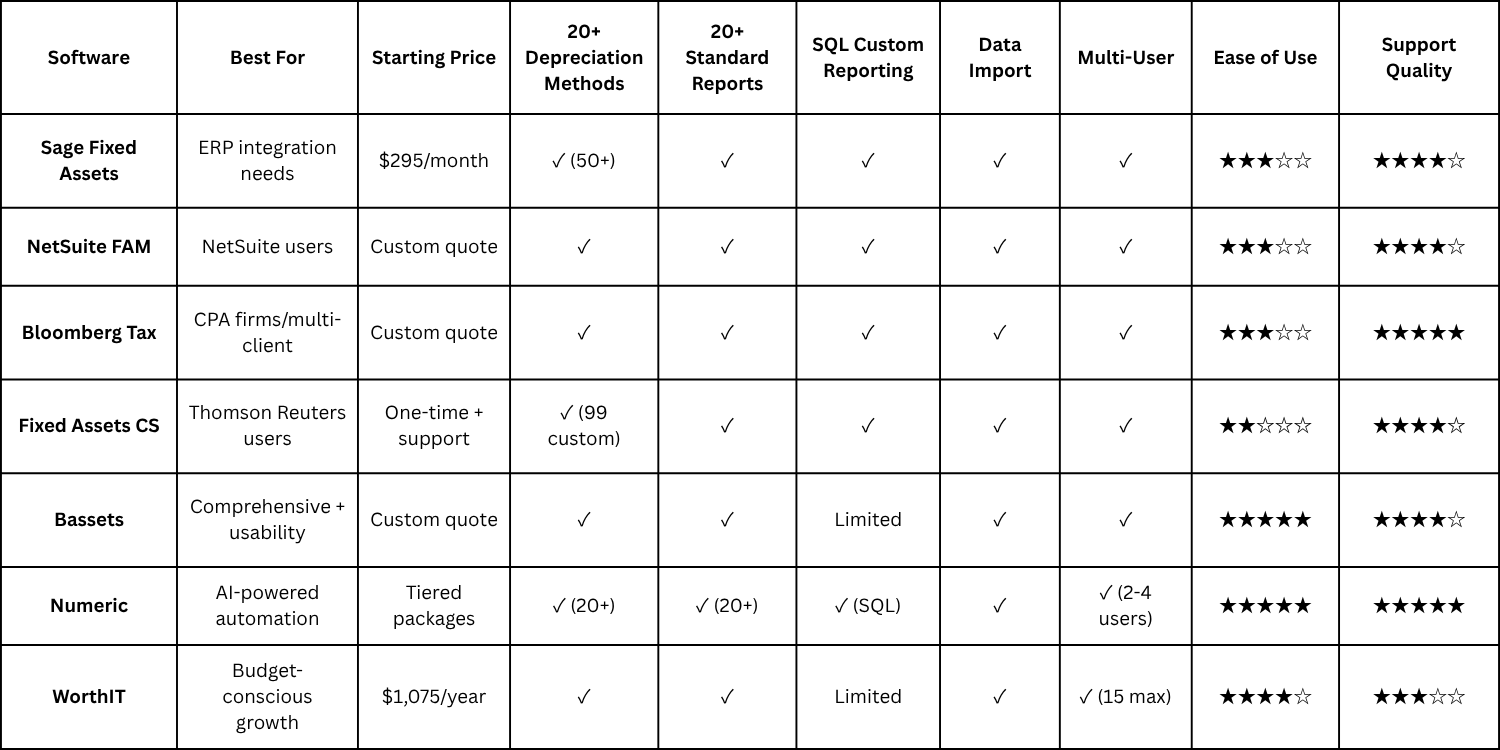
How to Use This Table: Start by identifying your must-have features from the Essential Features section, then narrow your choices to 2-3 solutions meeting those criteria. Pay particular attention to deployment model preference, asset capacity requirements, and support quality.
These factors often prove more important to long-term satisfaction than initial feature checklists. Schedule demos with your finalists to see the platforms in action before committing."
How to Choose the Right Fixed Asset Software for Your Enterprise
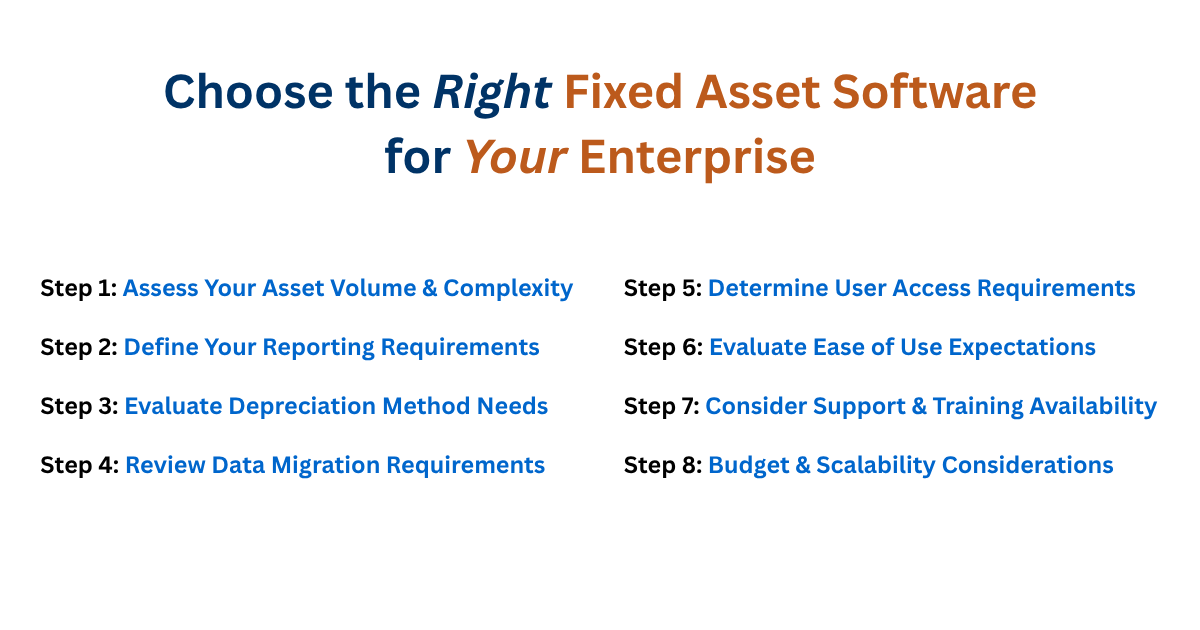
Selecting fixed asset accounting software requires balancing technical requirements, operational constraints, and budget realities. Follow this systematic framework to identify the solution that best fits your organization.
Step 1: Assess Your Asset Volume & Complexity
Count your current fixed assets and project 3-5 years forward. Consider both quantity (under 5,000, 5,000-20,000, or 20,000+) and complexity (standard equipment versus specialized assets like leased equipment under ASC 842, construction in progress, or international holdings requiring currency management).
Step 2: Define Your Reporting Requirements
Identify which financial reporting standards govern your organization—GAAP, IFRS, or industry-specific regulations. Determine your tax reporting needs, including federal MACRS, state-specific rules, and international considerations. Assess whether standard reports suffice or if you need extensive customization capabilities.
Step 3: Evaluate Depreciation Method Needs
Determine how many depreciation books you must maintain simultaneously—typically financial and tax at minimum, but potentially additional perspectives for management or regulatory reporting. Verify that your software supports every method you use, from standard straight-line and MACRS to specialized approaches like units-of-production.
Step 4: Review Data Migration Requirements
Assess your current system and historical data volume. Migrating from spreadsheets requires robust import validation, while replacing legacy software demands complete historical preservation. Larger migrations (10,000+ assets with transaction history) typically require professional services support.
Step 5: Determine User Access Requirements
Calculate how many users need simultaneous access and define their roles—asset managers, accountants, controllers, tax professionals. Consider whether you need approval workflows for acquisitions and disposals, which narrows your platform options.
Step 6: Evaluate Ease of Use Expectations
Match software complexity to your team's technical capabilities and available training time. If asset management involves non-accounting staff or faces high turnover risk, prioritize user-friendly platforms that enable quick proficiency.
Step 7: Consider Support & Training Availability
Determine whether you need dedicated implementation consultants or can manage self-service setup. Evaluate ongoing support quality—access to knowledgeable depreciation experts provides significantly more value than tier-1 technical support for complex scenarios and regulatory changes.
Step 8: Budget & Scalability Considerations
Analyze total cost of ownership over 3-5 years, including subscription fees, implementation costs, training, and data migration. Understand pricing models (per-asset, per-user, or fixed) and how they scale with growth. Factor in whether implementation services are included or charged separately, as this dramatically impacts true costs.
Quick Decision Checklist:
Pro Tip: Don't base your decision solely on features or price. Request live demos from your top 2-3 finalists and involve the people who will use the system daily in the evaluation. The best software is the platform your team will actually use effectively—which often comes down to usability and support quality more than feature checklists."
Frequently Asked Questions
Q: What is the best fixed asset management software?
The best solution depends on your needs. Enterprises prioritize Bassets for ease of use and comprehensive depreciation support. Cloud options like Sage Fixed Assets suit distributed teams. CPA firms prefer Bloomberg Tax Fixed Assets for multi-client management and tax software integration.
Q: What depreciation methods should fixed asset software support?
Enterprise-grade software should support 20+ methods including straight-line, MACRS, ACRS, declining balance variations (200%, 150%, 125%), sum-of-years-digits, and units-of-production. The ability to run multiple simultaneous depreciation books for financial, tax, and management reporting is essential for compliance.
Q: Is software considered a fixed asset?
Software qualifies as a fixed asset when purchased for long-term use (over one year) with significant upfront investment, like ERP systems, plant, equipment, or internally developed applications. However, subscription-based SaaS is typically expensed as an operating cost since you purchase access rights, not ownership.
Q: How do you track fixed assets in accounting?
Modern departments use dedicated fixed asset software that automatically calculates depreciation, maintains complete audit trails, generates compliance reports for financial statements and tax returns, and integrates with general ledger systems. This replaces error-prone spreadsheets with automated, accurate tracking supporting operations and compliance.
Q: What is the difference between asset management and fixed asset management?
Asset management encompasses all organizational assets—current assets, financial assets, and intangibles. Fixed asset management focuses specifically on long-term tangible assets (property, plant, equipment), addressing depreciation calculation, maintenance lifecycle management, physical location tracking, tax compliance, and disposal procedures.
Q: Can I use spreadsheets instead of fixed asset software?
Spreadsheets work for organizations with under 50 assets and simple depreciation. Beyond that, they become unmanageable and error-prone. Dedicated software automates complex calculations, ensures accuracy, provides audit trails, and supports compliance. Organizations implementing robust software reduce financial close time by up to 40%.

Finding software that balances power with usability isn't easy. If you're evaluating solutions that prioritize both comprehensive depreciation capabilities and ease of use, see how Bassets compares.
Schedule a personalized demo to explore how our platform handles your specific depreciation scenarios, or start a free trial to test it with your own asset data.
No high-pressure sales. Just a straightforward look at whether Bassets fits your needs.



.png)
